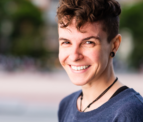Of all the vocally-demanding professions that our voice clients have, “choral director” is perhaps the most common. It’s to be expected really: voice problems are truly an occupational hazard for these tireless vocal athletes. Running large group rehearsals, teaching small group lessons, directing the school musical, not to mention teaching general music, sight-singing, music history, and music theory. They rarely get a break where they’re not using their voice; after all, don’t we remember as choral students, hanging out in the choir room during free periods? Our high school choir director was certainly never given time to rest his voice.
THE PROBLEMS:
So here are the challenges that choral directors face:
- Singing and talking all day long
- Talking over large numbers of students singing
- Not consistently using amplification, if at all
- Playing, singing, directing, and listening for errors – their attention is so divided, they’re not thinking about good vocal technique for themselves
- Not having time to warm up or recover between classes, rehearsals, lessons.
- Modeling voice parts at the HS level for soprano, alto, tenor, and bass, often out of their range
- Singing outside of school as well, in ensembles, recitals, and giving private voice lessons
For most people, any one of these tasks would be plenty. And chorus teachers do this all day, every day.
One of our voice graduates, Lauren D., a former school chorus teacher and now district teacher mentor, explains it like this: “I think for me, the amount I had to use my voice and the lack of time to recover was the worst. [Some] Classroom teachers give a mini-lesson and assign work. Choral directors are singing/talking all period long! It’s just SO much! I also struggled with not trying to sing/speak over my students. Not easy for me at all! It was always so stressful because your voice is your livelihood!”
And our voice client, chorus teacher Amy C. says: “Projecting the voice to get the students to do what you want, singing loudly to give students their pitches, pushing over the accompanist and other parts: those are my challenges.”
THE SOLUTIONS
If you’re a choral director, there is hope for your vocal health. (And some of these suggestions also work for classroom teachers and other vocal professionals).
- Warm-up the voice before class, even on the way to work or in the shower before work. Then throughout the day, do mini-warm-ups between classes or on a prep or break, including laryngeal massage, even for 1-4 minutes, to “reset” the voice.
- Try doing some of your warm-ups and stretches with your students. Their voices will benefit too!
- Inhale nebulized saline, from a portable nebulizer such as VocalMist, even if you only have 30-60 seconds. That instant moisture will soothe your vocal cords, break up moisture, and reduce the phonation threshold pressure needed to set your cords into vibration. In other words, you can work less, and produce a better sound.
- “Mark” some of your vocal modeling, instead of singing full out.
- Better yet, play the part on the piano instead of singing it, or delegate it to a capable student to model the vocal line for their section.
- Use non-verbal cues to quiet your students or get them to stop singing when you need to make a comment or correction. Don’t try to sing or talk over them while they’re singing.
- Pace yourself. Don’t use up all your vocal energy in Period 1, if you have to teach all day, run rehearsals after school, and then attend your own ensemble or theater rehearsal at night.
- Most importantly, use amplification for all of your teaching and directing. A body-worn personal amplifier like the ChatterVox is fine, but if your school has a PA system available, use that with a headset microphone. You’ll be hands-free to teach and play piano, and you can be heard without pushing your voice.
There’s also a selection of choral apps, which allow you (or your students) to play their part on their mobile device, and practice it without or without the other parts. This is by no means an exhaustive list:
- Choraline
- Singerhood
- Choirplayer.com – Very user friendly, with many useful features like backing tracks, ability to slow down or loop sections you need to work on, and soloing one choir part at a time, but light on classical choir repertoire. This might be better for community choruses or school choruses that do non-classical music.
- Learn My Part – This app also allows you to adjust how much volume you want to hear of the part the student needs to learn vs the volume of the other parts, and allows you to upload MIDI files of your own choral rep choices. It will display the PDF of the score. However, unlike the other apps, this app only plays the vocal part on piano or organ. It does not use singers’ voices.
Hopefully, these suggestions will help you to keep bringing the gift of vocal music to your students, pain and strain-free, for many years to come.






